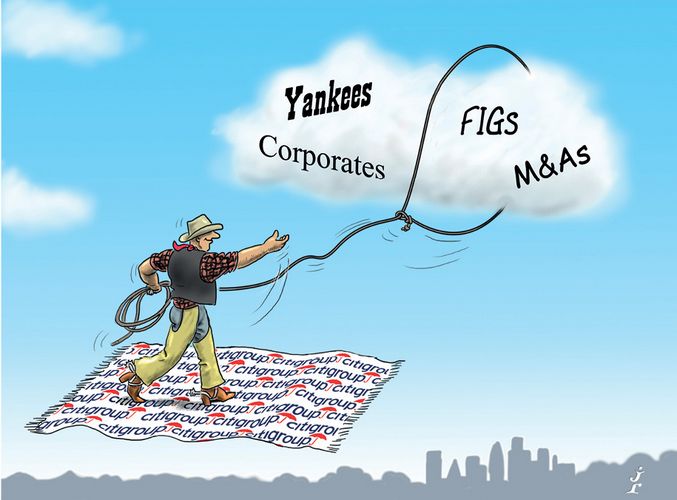Stand and deliver
In a year that saw all kinds of shocks and surprises, one bank consistently stood out from the rest by adeptly navigating the market’s changing winds and repeatedly delivering trend-setting transactions. Citigroup is IFR’s US Investment-Grade Bond House of the Year.
It was another busy year in the US high-grade market during 2016, with some US$1.3trn of deals coming to market. But despite the volumes, deal execution was far from straightforward.
Money-market reforms, the slump in crude prices, the shock votes for Donald Trump and Brexit, ongoing uncertainty about the next hike in rates – there was headline risk aplenty.
Against that backdrop, issuers had to be more careful about timing: they had to be opportunistic and pick their spots carefully. That put bookrunners under pressure to come up with strategies to help their clients navigate through often challenging conditions.
Citigroup excelled in this difficult climate, repeatedly proving its ability to deliver results for clients ranging from the most seasoned issuers to the relatively inexperienced.
Its robust balance sheet and global footprint allowed it to provide tailor-made solutions for borrowers of every kind.
“We were able to break new ground with innovative structures, navigating all-time record transaction sizes across sectors, piloting through front-end changes in market structure and championing unique execution strategies,” said Peter Aherne, Citigroup’s head of North America investment-grade capital markets.
The bank ranked third in the Thomson Reuters league table for the awards period, garnering a 10.3% market share after leading 358 deals for US$131.5bn.
Citigroup demonstrated an almost uncanny knack for bringing deals that reopened primary after difficult stretches and showed just how resilient the market is.
The bank also repeatedly proved it had its fingers on the pulse of global flow, manoeuvring through tricky waters as central banks hemmed and hawed on monetary policy.
It deftly handled reforms in the money markets in October that prompted a sharp rise in near-term borrowing rates and pushed up one-year funding costs.
Citigroup escorted a number of Yankee banks and finance companies through those changes to take advantage of term debt pricing.
The bank performed especially well in the days after the UK’s vote to leave the European Union, a surprise outcome that unleashed a fair bit of chaos on the global markets.
Citigroup was an active bookrunner on US$5.3bn of unsecured notes from Molson Coors Brewing in June, which restarted the primary sector after two days of no issuance globally.
The deal attracted some US$32bn in orders and was priced with little or no new issue concession.
Over the following four days, Citigroup was an active bookrunner on a US$4bn trade for Express Scripts, a US$14bn offering from Oracle and a US$1bn deal for Lloyds Banking Group – the latter reopening the market for financial institutions.
Investors placed US$7bn of orders for Lloyds’ US$1bn five-year deal, the first from a bank in US dollars after the Brexit vote. It was also Lloyds’ first senior holding company issue in dollars.
The deal was priced at 210bp over Treasuries, around 40bp wider than it would have been if the Brexit vote had gone the other way, said a banker on the transaction. But the bonds tightened by 20bp in the aftermarket.
Citigroup repeatedly excelled in landmark acquisition financings such as Dell’s US$20bn bond, Southern Company’s US$8.5bn seven-part trade and Aetna’s US$13bn eight-parter.
It led transactions for blue-chip multinationals including Walt Disney, Ford, McDonald’s, Johnson & Johnson, Coca-Cola, Shell International Finance and a host of others.
Yet the bank also showcased its talents with infrequent borrowers and other foreign issuers such as Air Liquide, SMBC Aviation Capital, WestJet Airlines and Yara.
Citigroup stood out in the financial sector, not least with its own own US$2bn seven-year non-call six floating-rate note offering.
The deal included a call option that was aimed at limiting the cost of compliance with expected total loss-absorbing capacity regulations.
It also led the way for other financial issuers that came to the market in September with similar structures.
And the bank helped numerous issuers such as Pemex, Target, Amgen and Google with liability management trades to take advantage of the low-rate environment.
“We had an excellent year as we maintained a top position in the league tables on every asset class and gained market share,” said Aherne. “The credit for that goes to our well-coordinated global bond franchise.”
To see the digital version of this review, please click here.
To purchase printed copies or a PDF of this review, please email gloria.balbastro@tr.com
